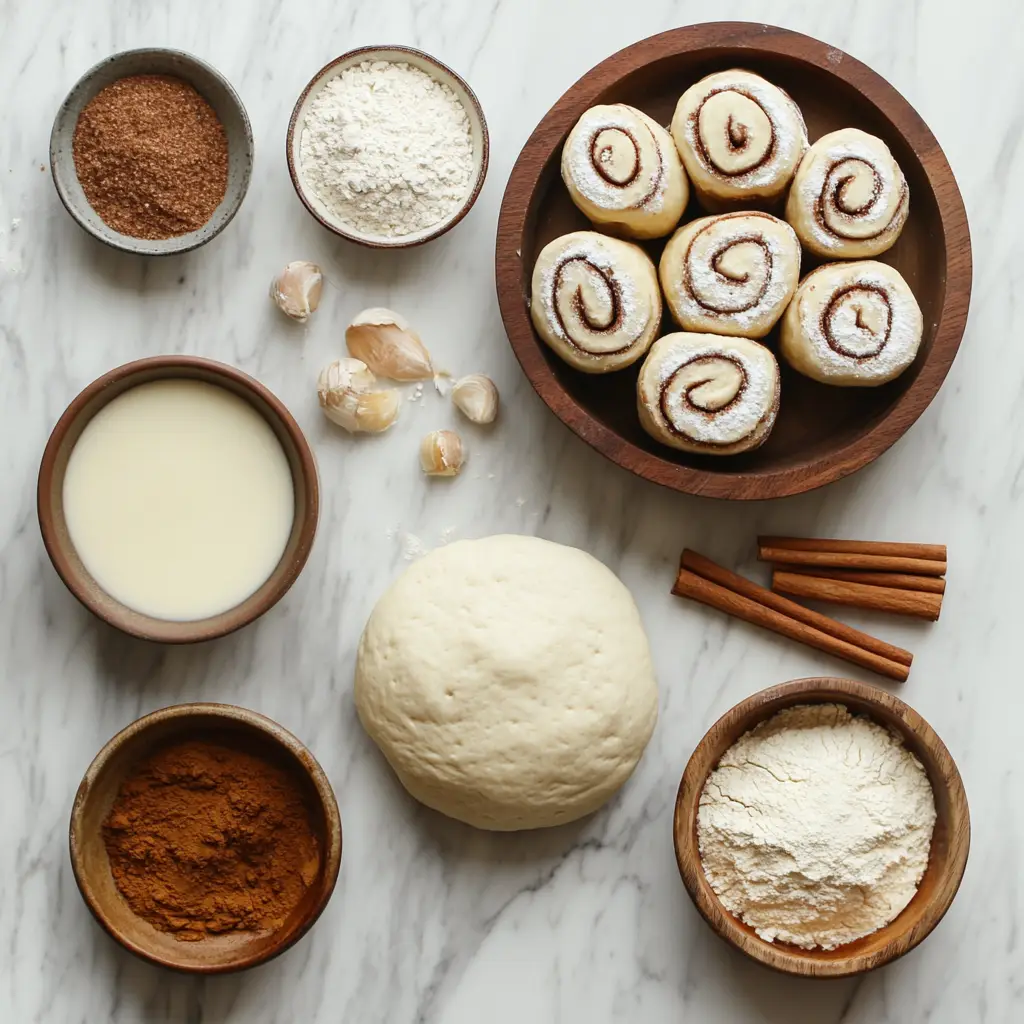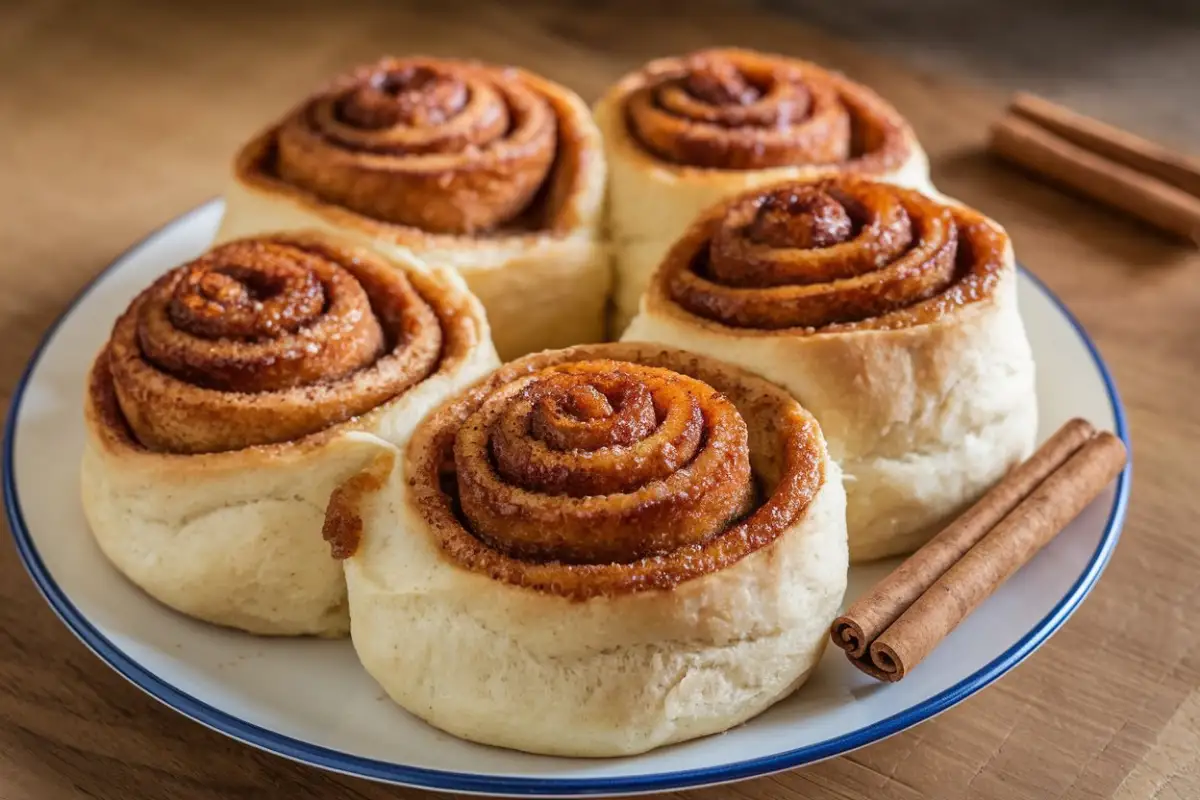Few baked goods can rival the joy of biting into a warm, gooey cinnamon roll. Now, imagine that classic comfort combined with the rich, tangy flavor of sourdough. This Sourdough Cinnamon Rolls Recipe takes your homemade cinnamon rolls to the next level, offering a unique depth of flavor and an irresistibly fluffy texture.
Whether you’re using your sourdough starter or simply love experimenting in the kitchen, this Sourdough Cinnamon Rolls Recipe guarantees success. Plus, the natural fermentation process enhances digestibility, making these rolls a healthier, more flavorful option.
Why Choose Sourdough for Cinnamon Rolls?
Sourdough cinnamon rolls stand out not just for their taste but also for their nutritional and textural benefits. Unlike traditional yeast-based rolls, sourdough incorporates a natural fermentation process that enhances flavor, improves digestibility, and creates a uniquely soft and tender crumb. Let’s dive into why sourdough is the superior choice for crafting the perfect cinnamon roll.
The Benefits of Sourdough in Baking
Sourdough baking has been cherished for centuries, and for good reason. The fermentation process offers several advantages:
- Enhanced Digestibility: The natural fermentation of sourdough breaks down gluten and phytic acid, making the dough easier on your stomach. This is particularly beneficial for people with mild gluten sensitivities.
- Improved Flavor: Sourdough develops complex, tangy, and slightly nutty flavors during fermentation. These flavors balance beautifully with the sweetness of the cinnamon roll filling.
- Longer Shelf Life: The organic acids produced during fermentation naturally preserve the dough, keeping your cinnamon rolls fresher for longer.
Unique Flavor Profiles of Sourdough Cinnamon Rolls
One of the most exciting aspects of sourdough cinnamon rolls is their nuanced flavor. The tangy undertones of the sourdough complement the sugary, spiced filling in a way that traditional dough cannot replicate. Here’s why the flavor stands out:
- Tanginess Meets Sweetness: The slight acidity in sourdough adds depth to the sweetness of the cinnamon and sugar mixture, creating a balanced flavor profile.
- Caramelized Notes: The slow fermentation process enhances the caramelization of sugars during baking, offering a rich and satisfying taste.
Sourdough vs. Traditional Dough: What’s the Difference?
Comparing sourdough to traditional yeast-based dough highlights why sourdough is worth the extra effort:
Ingredients for Sourdough Cinnamon Rolls

Crafting sourdough cinnamon rolls begins with understanding the ingredients required. High-quality components ensure the best flavor and texture for your baked goods.
Ingredients for the Perfect Sourdough Cinnamon Rolls Recipe
Crafting the best Sourdough Cinnamon Rolls Recipe starts with high-quality ingredients.
Dough Ingredients:
- Sourdough Starter – The key to achieving the rich depth of flavor in this homemade Sourdough Cinnamon Rolls Recipe.
- All-Purpose Flour – Provides structure while keeping the rolls soft.
- Milk & Eggs – Add richness and moisture.
- Butter & Sugar – Enhance flavor and tenderness.
Cinnamon Filling Ingredients:
- Brown Sugar & Cinnamon – The classic combination that makes this Sourdough Cinnamon Rolls Recipe irresistible.
- Butter – Helps the filling stick and adds richness.
Optional Toppings and Variations
Want to customize your sourdough cinnamon rolls? Consider these ideas:
- Nuts and Raisins – Add texture and a hint of sweetness.
- Cardamom or Nutmeg – For a spiced twist on the classic flavor.
- Cream Cheese or Maple Frosting – Finish your rolls with a decadent topping.
Why This Sourdough Cinnamon Rolls Recipe Stands Out
Unlike store-bought versions, this Sourdough Cinnamon Rolls Recipe uses a natural fermentation process that:
- Enhances Flavor – The slight tanginess of sourdough perfectly balances the rich, sugary filling.
- Improves Texture – This homemade Sourdough Cinnamon Rolls Recipe produces a soft, tender crumb that stays fresher longer.
- Boosts Nutrition – The fermentation process helps break down gluten, making these rolls easier to digest.
If you’re looking for a flavor-packed Sourdough Cinnamon Rolls Recipe, this one guarantees incredible taste and texture with minimal effort.
The Benefits of Sourdough in Baking
Sourdough baking has been cherished for centuries, and for good reason. The fermentation process offers several advantages:
- Enhanced Digestibility: The natural fermentation of sourdough breaks down gluten and phytic acid, making the dough easier on your stomach. This is particularly beneficial for people with mild gluten sensitivities.
- Improved Flavor: Sourdough develops complex, tangy, and slightly nutty flavors during fermentation. These flavors balance beautifully with the sweetness of the cinnamon roll filling.
- Longer Shelf Life: The organic acids produced during fermentation naturally preserve the dough, keeping your cinnamon rolls fresher for longer.
Unique Flavor Profiles of Sourdough Cinnamon Rolls Recipe
One of the most exciting aspects of sourdough cinnamon rolls is their nuanced flavor. The tangy undertones of the sourdough complement the sugary, spiced filling in a way that traditional dough cannot replicate. Here’s why the flavor stands out:
- Tanginess Meets Sweetness: The slight acidity in sourdough adds depth to the sweetness of the cinnamon and sugar mixture, creating a balanced flavor profile.
- Caramelized Notes: The slow fermentation process enhances the caramelization of sugars during baking, offering a rich and satisfying taste.
Sourdough vs. Traditional Dough: What’s the Difference?
Comparing sourdough to traditional yeast-based dough highlights why sourdough is worth the extra effort:
Ingredients for Sourdough Cinnamon Rolls Recipe
Crafting sourdough cinnamon rolls begins with understanding the ingredients required. High-quality components ensure the best flavor and texture for your baked goods.
Key Ingredients for the Dough
The dough is the foundation of your cinnamon rolls, and each ingredient plays a crucial role:
- Sourdough Starter – The heart of the recipe, providing natural leavening and flavor.
- All-Purpose Flour – Offers structure to the dough while keeping it soft.
- Milk – Adds moisture and tenderness.
- Eggs – Contribute richness and bind the dough together.
- Butter – Enhances flavor and creates a soft, luscious texture.
- Sugar – A touch of sweetness in the dough to balance the sourdough tang.
Essential Ingredients for the Filling
The filling is what makes cinnamon rolls so irresistible. Here’s what you’ll need:
- Brown Sugar – Adds a molasses-like richness that pairs well with cinnamon.
- Cinnamon – The star spice that defines these rolls.
- Butter – Helps the filling stick to the dough and adds richness.
Optional Toppings and Variations
Want to customize your sourdough cinnamon rolls? Consider these ideas:
- Nuts and Raisins – Add texture and a hint of sweetness.
- Cardamom or Nutmeg – For a spiced twist on the classic flavor.
- Cream Cheese or Maple Frosting – Finish your rolls with a decadent topping.
Sourdough Cinnamon Rolls Recipe Frosting Options
No cinnamon roll is complete without a rich, decadent frosting to tie all the flavors together. Whether you prefer the classic cream cheese variety, a simple glaze, or a dairy-free alternative, there are options to suit every taste.
Classic Cream Cheese Frosting
Cream cheese frosting is the quintessential topping for cinnamon rolls, offering a tangy sweetness that pairs perfectly with the rich sourdough base.
- Ingredients:
- 4 ounces cream cheese, softened
- 4 tablespoons unsalted butter, softened
- 1 teaspoon vanilla extract
- 1–2 cups powdered sugar
- 2 tablespoons milk or heavy cream (for desired consistency)
- Preparation:
- Beat the cream cheese and butter together until smooth and creamy.
- Add the vanilla extract and mix well.
- Gradually sift in powdered sugar, mixing between additions, until the frosting reaches your desired sweetness.
- Add milk or cream a tablespoon at a time to achieve a spreadable consistency.
- Tips for Application:
- Spread the frosting over the cinnamon rolls while they are still slightly warm. This allows the frosting to melt slightly, creating a luscious glaze-like texture.
Glaze with a Twist: Maple or Vanilla
For a lighter option, a simple glaze can be just as delicious. Adding maple syrup or vanilla gives it a unique flavor twist.
- Maple Glaze:
- Mix 1 cup powdered sugar with 2 tablespoons maple syrup and 1–2 tablespoons milk.
- Whisk until smooth and drizzle over the rolls.
- Vanilla Glaze:
- Combine 1 cup powdered sugar, 1 teaspoon vanilla extract, and 2–3 tablespoons milk.
- Stir until smooth and pour over the cinnamon rolls for a classic finish.
- Customization Ideas:
- Add a pinch of cinnamon or nutmeg to the glaze for extra spice.
- Use almond extract instead of vanilla for a subtle nutty flavor.
Dairy-Free and Vegan Frosting Alternatives
For those with dietary restrictions, you can create equally indulgent frostings without using dairy:
- Coconut Cream Frosting:
- Use canned coconut cream as the base. Whip it with powdered sugar and vanilla extract for a fluffy, dairy-free topping.
- Cashew Cream Frosting:
- Blend soaked cashews with maple syrup, vanilla, and a splash of almond milk until smooth. This creates a creamy, vegan alternative with a nutty undertone.
- Tips for Success:
- Ensure your non-dairy ingredients, such as vegan butter or cream cheese, are at room temperature for easy blending.
- Add plant-based milk gradually to achieve your preferred consistency.
Troubleshooting and Tips for Sourdough Cinnamon Rolls Recipe
While making sourdough cinnamon rolls can seem intimidating, these tips will help ensure success every time.
Common Issues and How to Solve Them
- Dense Rolls:
- Cause: Underproofing or inactive sourdough starter.
- Solution: Ensure the starter is bubbly and active, and allow enough time for the dough to rise.
- Dry Rolls:
- Cause: Overbaking or using too much flour.
- Solution: Bake just until golden and use a kitchen scale for accurate flour measurement.
- Sticky Dough:
- Cause: Insufficient kneading or overly wet dough.
- Solution: Knead until smooth and elastic, and dust your surface lightly with flour while rolling.
Conclusion
Making sourdough cinnamon rolls at home is a rewarding baking project that combines the comforting sweetness of traditional rolls with the unique tanginess of sourdough. From crafting the perfect dough to experimenting with frosting options, every step allows you to customize the recipe to your taste and dietary preferences.
These rolls are not only a treat for the palate but also a testament to the beauty of slow baking. The natural fermentation process gives the rolls a rich depth of flavor and makes them a healthier option compared to traditional yeast-based recipes. Whether you’re preparing them for a weekend breakfast, a festive brunch, or simply as a comforting indulgence, sourdough cinnamon rolls are sure to impress.
So, grab your sourdough starter, roll up your sleeves, and create a batch of these delightful rolls. With this detailed guide, you’ll be enjoying warm, gooey, and perfectly spiced sourdough cinnamon rolls in no time.

